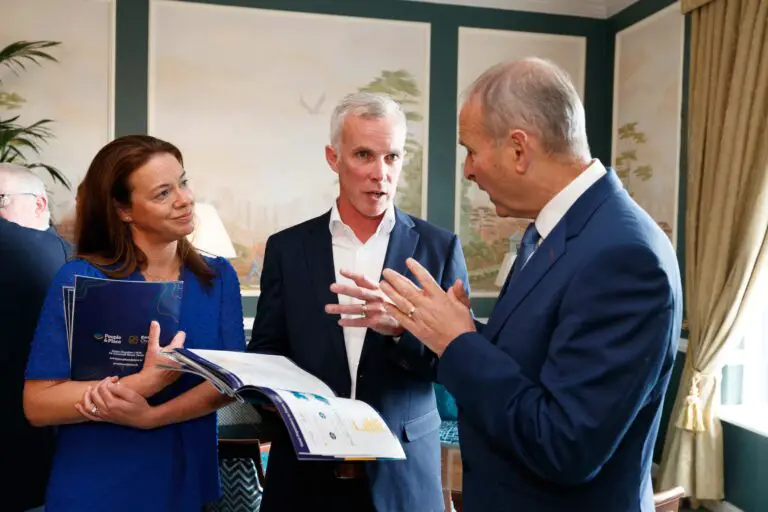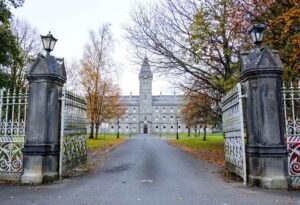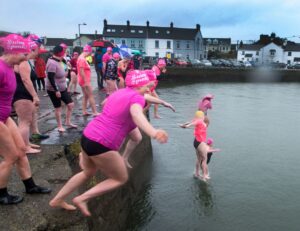*Clare Malone and Justin Gleeson of People & Place with Tánaiste Micheál Martin (FF). Photograph: Eamon Ward
ENNIS’ catchment population living within a one-hour drive is larger than that of Limerick and Galway City, according to a new report.
A new report called ‘Ennis – a socio-economic profile’ produced by People & Place consultants, was launched at the Ennis Chamber President’s Lunch last Friday.
The report, using data from Census 2022, notes that the population of Ennis is 27,923, making it the largest town in the West of Ireland and the fourth biggest town in Ireland. Ennis has a catchment area of 181,335 within a 30-minute drive and a catchment of 575,828 within a one-hour drive, which is larger than both Limerick and Galway cities.
Justin Gleeson, author of the report and consultant/founder of People & Place, said, “The data confirms the status of Ennis as one of the top tier towns in the country with enormous potential for sustainable development and economic growth in the coming decades.
“The central location of Ennis between the western cities of Galway and Limerick, the strength of the highly educated and skilled population within our catchment and our easy access to world class environmental and marine amenities makes Ennis a great option for future economic and civic investments.”
Mr Gleeson told The Clare Echo that the report “highlights how strong and positive a place Ennis is. Compared to towns like Sligo, Athlone, Kilkenny, Dundalk, we get a third of the investment these other towns have. We shouldn’t be happy with that. This report shows that Ennis should be attracting IDA investment and a couple of big companies would make an enormous difference to the town and county.
“When you live in Ennis you don’t realise how strong it is relative to other towns. In terms of education, population and what we have on our doorstep, there’s a unique opportunity here, the economic baseline of the town is growing with skilled people moving home with remote working, Ennis is in a really strong position to capitalise on these things.”
Ennis Chamber partnered People & Place to produce this insightful socio-economic profile of Ennis. Sheila Lynch, Ennis Chamber President commented, “This powerful fact-based document will assist stakeholders and investors to make well-informed decisions, promoting sustainable growth, while attracting new, much needed investment to Ennis.”
Margaret O’Brien, CEO Ennis Chamber said, “The information and insights in this profile will greatly benefit and assist our locally elected public representatives and will help shape policy for Ennis.
The Ennis – Socio Economic Profile includes insights into the local and regional labour market, including skill and education levels, employment rates and commuting patterns.”
The socio-economic report, supported by Ennis Chamber, provides a detailed analysis of the town’s demographic, social and economic characteristics and compares the town’s performance with national and regional towns of similar size across Ireland.
It noted that Ennis has 18,228 residents of working age (15-64), adding that there are more than 370,000 people of working age within a one-drive of Ennis.
Less than half of resident workers in Ennis work in the town. Some 42 per cent work in Ennis, while almost 38 per cent leave Ennis for employment opportunities each day (19.5% elsewhere in Clare, 18.3 per cent outside the county). The remaining 20 per cent are mobile workers or their answer was illegible.
Of the known 10,628 jobs in Ennis, some 51 per cent of the workers come from elsewhere in Clare or outside the county (10%). According to the report, Ennis has the highest number of workers commuting to work in a private car of all large towns in the Midwest, and the 6th highest percentage when compared to large towns across the country. Ennis also has the second highest percentage in Ireland of students (2nd and 3rd level) commuting to education in a private car.
The 35-page report is available at https://www.ennischamber.ie/wp-content/uploads/2024/07/Ennis_SocioEconomicProfile_Census2022.pdf


















